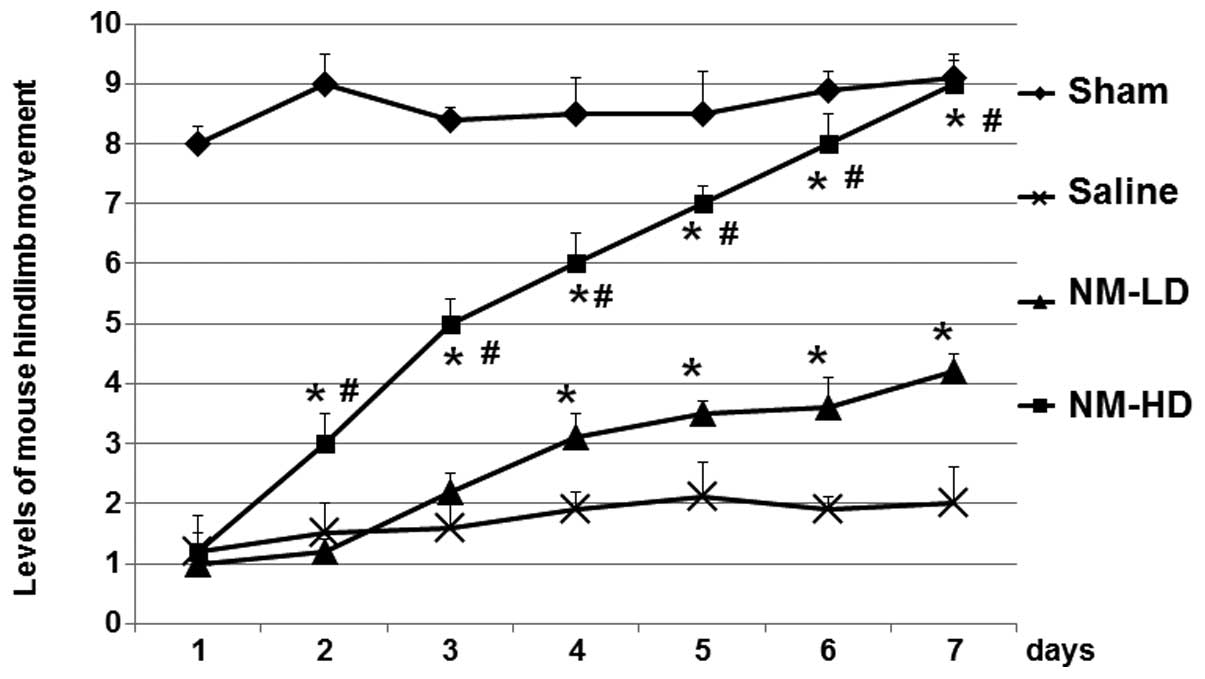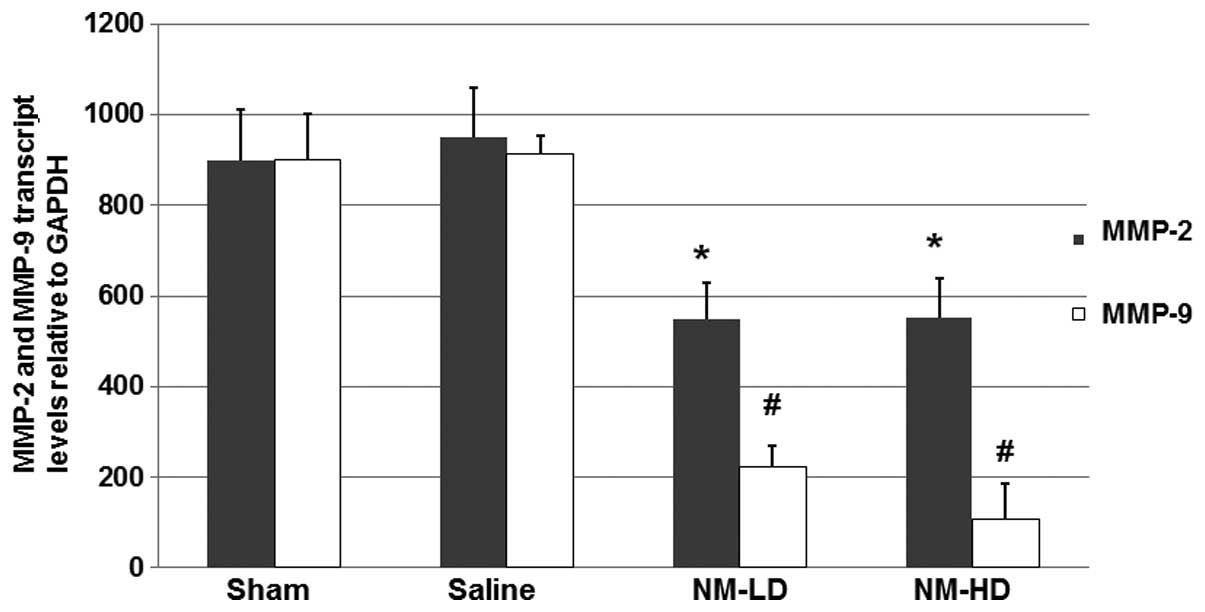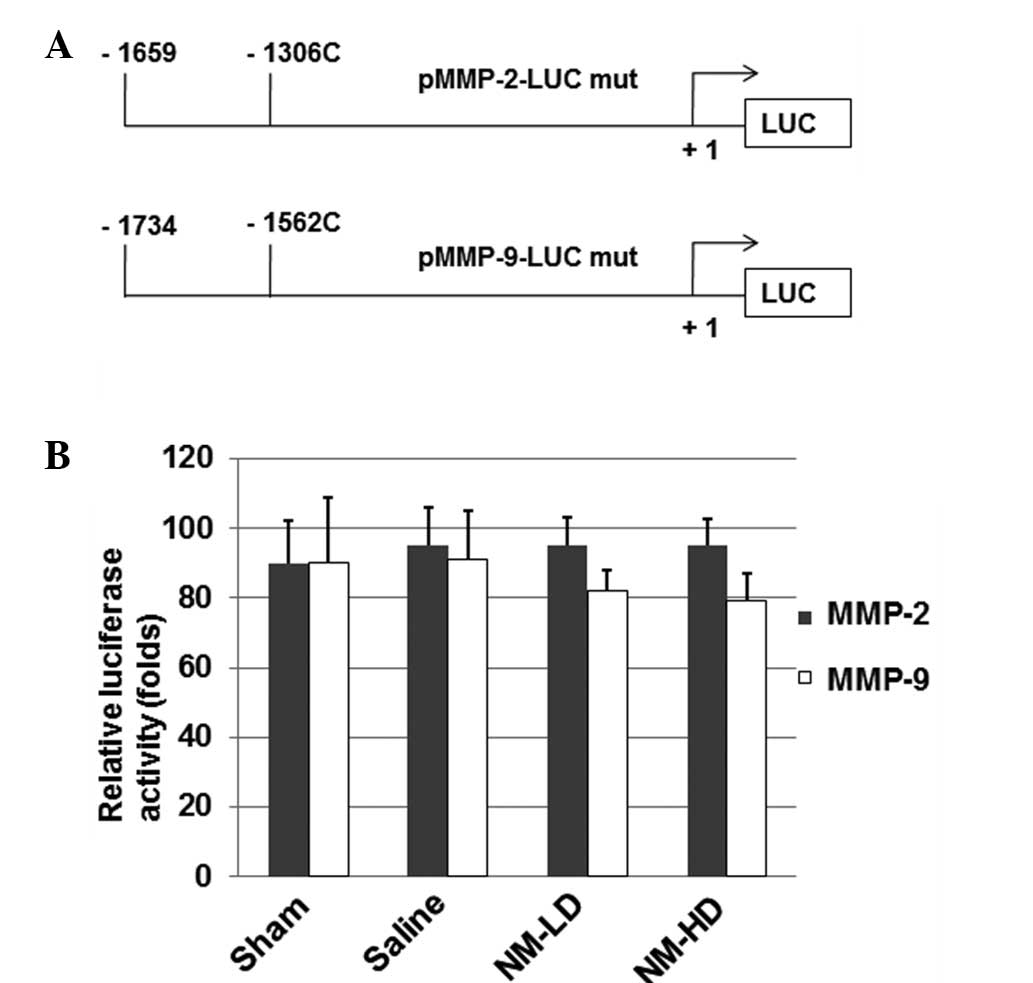|
1
|
Kenney K and Diaz-Arrastia R: Review of
traumatic brain and spinal cord injury: challenges and
developments. JAMA Neurol. 70:13332013. View Article : Google Scholar
|
|
2
|
Neirinckx V, Cantinieaux D, Coste C, et
al: Spinal cord injuries - how could adult mesenchymal and neural
crest stem cells take up the challenge? Stem Cells. 32:829–843.
2014. View Article : Google Scholar : PubMed/NCBI
|
|
3
|
Papa S, Rossi F, Ferrari R, et al:
Selective nanovector mediated treatment of activated
proinflammatory microglia/macrophages in spinal cord injury. ACS
Nano. 7:9881–9895. 2013. View Article : Google Scholar : PubMed/NCBI
|
|
4
|
Nelissen S, Vangansewinkel T, Geurts N, et
al: Mast cells protect from post-traumatic spinal cord damage in
mice by degrading inflammation-associated cytokines via mouse mast
cell protease 4. Neurobiol Dis. 62:260–272. 2014. View Article : Google Scholar : PubMed/NCBI
|
|
5
|
Ahmad FU, Wang MY and Levi AD: Hypothermia
for acute spinal cord injury - a review. World Neurosurg.
82:207–214. 2014. View Article : Google Scholar : PubMed/NCBI
|
|
6
|
Yamamoto A, Matsubara K, Kano F and Sakai
K: Analysis of the neuroregenerative activities of mesenchymal stem
cells in functional recovery after rat spinal cord injury. Methods
Mol Biol. 1213:321–328. 2014. View Article : Google Scholar : PubMed/NCBI
|
|
7
|
Bareyre FM and Schwab ME: Inflammation,
degeneration and regeneration in the injured spinal cord: insights
from DNA microarrays. Trends Neurosci. 26:555–563. 2003. View Article : Google Scholar : PubMed/NCBI
|
|
8
|
DeWitt DS, Prough DS, Taylor CL and
Whitley JM: Reduced cerebral blood flow, oxygen delivery, and
electroencephalographic activity after traumatic brain injury and
mild hemorrhage in cats. J Neurosurg. 76:812–821. 1992. View Article : Google Scholar : PubMed/NCBI
|
|
9
|
Kruman II and Mattson MP: Pivotal role of
mitochondrial calcium uptake in neural cell apoptosis and necrosis.
J Neurochem. 72:529–540. 1999. View Article : Google Scholar : PubMed/NCBI
|
|
10
|
Pedersen MO, Jensen R, Pedersen DS, et al:
Metallothionein-I+II in neuroprotection. Biofactors. 35:315–325.
2009. View
Article : Google Scholar : PubMed/NCBI
|
|
11
|
Takahashi H, Manaka S and Sano K: Changes
in extracellular potassium concentration in cortex and brain stem
during the acute phase of experimental closed head injury. J
Neurosurg. 55:708–717. 1981. View Article : Google Scholar : PubMed/NCBI
|
|
12
|
Yamakami I and McIntosh TK: Effects of
traumatic brain injury on regional cerebral blood flow in rats as
measured with radiolabeled microspheres. J Cereb Blood Flow Metab.
9:117–124. 1989. View Article : Google Scholar : PubMed/NCBI
|
|
13
|
Zemper ED: Analysis of cerebral concussion
frequency with the most commonly used models of football helmets. J
Athl Train. 29:44–50. 1994.PubMed/NCBI
|
|
14
|
Lau BY, Fogerson SM, Walsh RB and Morgan
JR: Cyclic AMP promotes axon regeneration, lesion repair and
neuronal survival in lampreys after spinal cord injury. Exp Neurol.
250:31–42. 2013. View Article : Google Scholar : PubMed/NCBI
|
|
15
|
Nakano N, Nakai Y, Seo TB, et al: Effects
of bone marrow stromal cell transplantation through CSF on the
subacute and chronic spinal cord injury in rats. PLoS One.
8:e734942013. View Article : Google Scholar : PubMed/NCBI
|
|
16
|
Liotta LA, Tryggvason K, Garbisa A, et al:
Metastatic potential correlates with enzymatic degradation of
basement membrane collagen. Nature. 284:67–68. 1980. View Article : Google Scholar : PubMed/NCBI
|
|
17
|
Stetler-Stevenson WG: The role of matrix
metalloproteinases in tumor invasion, metastasis and angiogenesis.
Surg Oncol Clin N Am. 10:383–392. 2001.PubMed/NCBI
|
|
18
|
Stetler-Stevenson WG: Type IV collagenases
in tumor invasion and metastasis. Cancer Metastasis Rev. 9:289–303.
1990. View Article : Google Scholar : PubMed/NCBI
|
|
19
|
Vlodavsky E, Palzur E and Soustiel JF:
Hyperbaric oxygen therapy reduces neuroinflammation and expression
of matrix metalloproteinase-9 in the rat model of traumatic brain
injury. Neuropathol Appl Neurobiol. 32:40–50. 2006. View Article : Google Scholar : PubMed/NCBI
|
|
20
|
Hansen CN, Fisher LC, Deibert RJ, et al:
Elevated MMP-9 in the lumbar cord early after thoracic spinal cord
injury impedes motor relearning in mice. J Neurosci.
33:13101–13111. 2013. View Article : Google Scholar : PubMed/NCBI
|
|
21
|
Miao X, Yu C, Tan W, et al: A functional
polymorphism in the matrix metalloproteinase-2 gene promoter
(−1306C/T) is associated with risk of development but not
metastasis of gastric cardia adenocarcinoma. Cancer Res.
63:3987–3990. 2003.
|
|
22
|
Markiewicz L, Majsterek I, Przybylowska K,
et al: Gene polymorphisms of the MMP1, MMP9, MMP12, IL-1β and TIMP1
and the risk of primary open-angle glaucoma. Acta Ophthalmol.
91:e516–e523. 2013.PubMed/NCBI
|
|
23
|
Roomi MW, Kalinovsky T, Niedzwiecki A and
Rath M: Modulation of u-PA, MMPs and their inhibitors by a novel
nutrient mixture in pediatric human sarcoma cell lines. Int J
Oncol. 43:1027–1035. 2013.
|
|
24
|
Basso DM, Fisher LC, Anderson AJ, et al:
Basso Mouse Scale for locomotion detects differences in recovery
after spinal cord injury in five common mouse strains. J
Neurotrauma. 23:635–659. 2006. View Article : Google Scholar : PubMed/NCBI
|
|
25
|
Kankaanranta H, Ilmarinen P, Zhang X, et
al: Tumour necrosis factor-α regulates human eosinophil apoptosis
via ligation of TNF-receptor 1 and balance between NF-κB and AP-1.
PLoS One. 9:e902982014.
|
|
26
|
Tang M, Shi S, Guo Y, et al: GSK-3/CREB
pathway involved in the gx-50’s effect on Alzheimer’s disease.
Neuropharmacology. 81:256–266. 2014.PubMed/NCBI
|














